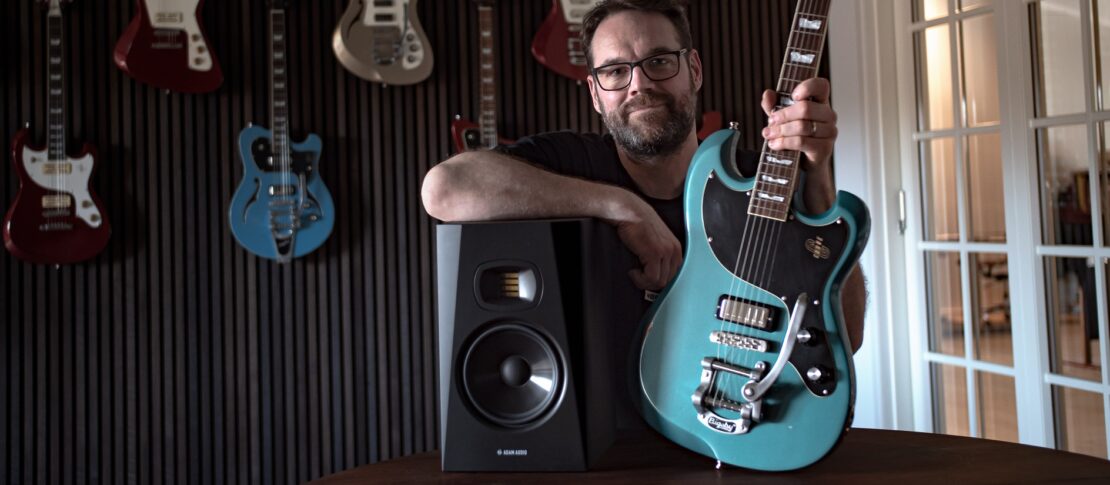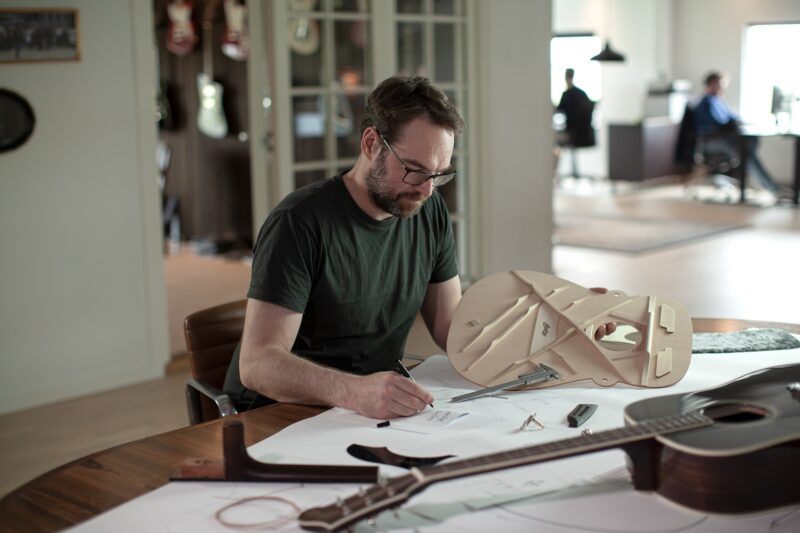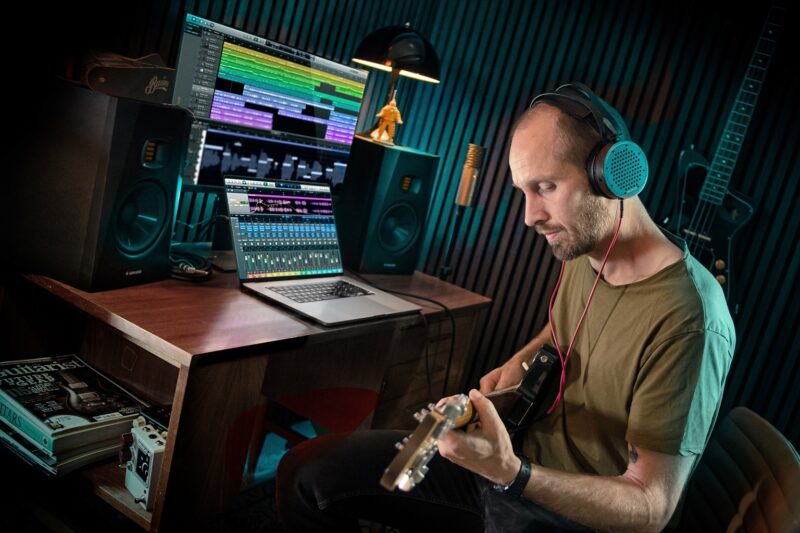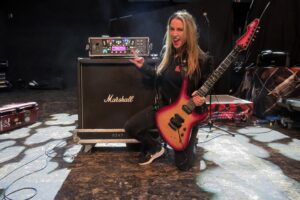
Blending vintage and modern with Baum Guitars
Hi Jeppe, thanks for doing this interview with us! Let’s start with a few questions regarding Baum Guitars’ background: How did you guys start building guitars? What was/is your motivation?
Hey there! Thanks for having us here. Baum Guitars started from a love for music, woodwork, and design. And combined into one product, that’s the electric guitar. We want to empower musicians to create and share music with the world. The guitar is so much more than just a tool or a product. It creates and shapes the culture around us through the music it’s involved in.
And to empower and push boundaries, Baum Guitars brings new guitars to the stage. New designs. New sounds. New guitars this generation of players can make their own signature instruments. Our guitars combine the Danish minimalistic design looks with smooth and modern playability.
And it all started years ago. Baum Guitars is the culmination of decades of guitar building and a passion for design. And in 2015, Morten Bau founded Baum Guitars officially with our signature design universe. The Conquer 59, Leaper Tone, Wingman, and Backwing were the first models in the Baum line-up. And the line-up grew year by year. And now we’re here!
Could you please give us a short description of the company? When did you start? How was it at the beginning and how do you compare it with nowadays?
As a Danish company, the obvious thing that defines the brand is our design rooted in Danish aesthetics. That’s the first thing a player will notice when guitar shopping and seeing all the different guitars on the wall.
And when you pick up a Baum, you will feel that the guitars have their own vibe as well. We’re not here to just recreate old guitars. Instead, we have carefully selected our favorite specs from different custom guitars built in Denmark throughout the years and chosen those that work well together and form a new vibe. We have a holistic approach to guitar making. Everything is there for a reason. You will feel that all pieces fit perfectly together to create a perfectly balanced instrument. Visually, sonically, and playing-wise.
Our biggest difference from when we started to today is our size and instrument line-up. We have grown from a one-man basement builder to a small business doing this as our full-time job. And from a single guitar at the time to an actual production of guitars.
Could you give us a short run-down of your workshop?
It all starts in Denmark, and the manufacturing depends on the series. Our headquarter and workshop in Denmark are the epicenter of everything we do. This is where we build custom shop guitars, our Revival models, and where we design and develop new models. It takes time to build character into an instrument, and we take the time to do it properly. Our Custom shop can do everything in-house from woodwork, pickguards, to painting and final assembly. From a piece of wood to a unique instrument.
Our instruments have several Baum-designed elements like our custom-made Levitator™ bridge and our own brand of Goldsound® pickups. Likewise, pickguards, truss rod covers etc. are all custom-made design elements to make a Baum stand out.
We tend to work the smartest way. What can be CNC’ed during production will be made on CNC. This is because some processes require the highest element of precision and consistency. And then other processes require a skilled luthier’s know-how to be done properly. In combination, this makes the best guitar with consistent quality and individual character.
In today’s global world, where the manufacturer is placed is secondary if you just have the right one for your products. I mean, the best phone is made in China, right? We develop and design everything, and our manufacturers work as a direct extension of Baum. We have spent a lot of time finding manufacturers who understand our concepts and can deliver our quality. This goes for both our guitars, basses, hardware, and pickups. This is very important to us.
And finally, everything comes to Denmark for quality control and set-up before we ship it. We like to say “hi” to each guitar before it leaves for its next home somewhere in the world.

What is your creative process when designing a new guitar? To what extent do you bring in professionals to shape the end product?
It all starts with an idea of something new. We are so privileged that we can do everything ourselves. Morten Bau, our founder, has both a designer’s brain and an engineer’s. He can go through the process of a new idea to a complete product – from raw sketches to 3D modeling. And from 3D to an actual prototype in wood. We can then start prototyping with our manufacturers at this stage. And because our drawings and 3D files are so precise, and our manufacturers are aligned with our concepts, we can move into this phase pretty fast.
We do test runs with our artist network once we have the first prototypes. We try to include a variety of players on these test days because different plays notice different things. Some are very particular about neck shapes or weight, others about pickups and sounds. Final colors are often chosen by our Baum family online. We like to do these Battles on Instagram with color A vs color B, and that allows our players to define what the next color on a model should be.
What has been your most popular guitar?
That is the Wingman. Which also is our most unique model. This just confirms our idea that today’s players want something fresh. Something they can make their own.
As manufacturers of studio monitors, one thing we see more and more is, that guitarists use modeling amps with studio monitors instead of traditional guitar cabs. What is your take on this?
We use it all the time in our studio today. And it’s great! Digital gear has really been revolutionized throughout the last 5-10 years. Just look at Kemper, Helix, Fractal, and Neural DSP these days. We use the small HX Stomp in combination with the ADAM Audio T7V and T10S Subwoofer (perfect for bass tones too!) in the studio, and not only does it sound amazing, but the convenience and consistency are perfect for our workflow. And using a setup with studio monitors means that what we hear is one-to-one with what we record. That is super useful.
When going digital, the feeling is a little different, and you have to work a little extra on the guitar tones to get them right. A quick tip: Combining the digital modelers with analog pedals in front makes a huge difference to the feel. So, we usually put our pedalboard in front of the HX Stomp with different flavors of overdrive pedals. This setup is so much easier for us than recording a guitar amp the old way. Especially in our environment where our small studio is next to our workshop on one side (with noisy machines) and office on the other side (with meetings and where we try to focus), having the opportunity to either record with low volume and without mic’d amps is crucial to our needs.

What role do studio monitors play in the workflow of modern guitarists?
Oviously, having a transparent pair of monitors is important to get a clear picture of your recordings. But one of the major shifts in the workflow of today’s guitarists is that good studio monitors have become so accessible. And in combination with the improvement of today’s modelers, today’s guitarists can build a budget-friendly home studio. And sound great!
What’s your opinion about guitarists recording themselves in home studios (straight into the interface, without micing an amp)?
It’s great because it allows so many musicians to record and share their music, and we can see a boom of amazing new players online. It’s really inspiring to see how social media is full of talented guitarists who are now able to record and share their music from home. You don’t need a cranked vintage Fender twin or Marshall JTM45 to sound good. And while we love good old tube amps here at the office, they have kind of become obsolete. They’re nice to have, but definitely not need to have anymore.
What do you think about the new software and plugins for guitarists? Have these changed the creative process for guitar players? And how do you compare these with analog effects and amps for example?
The options available today sound great, they’re easy to use and they’re so inspiring to use. An entire amp and pedal collection available to load within seconds gives you many possibilities to be creative. But it can also sometimes lead to option paralysis as well. That said, there is something about physical gear. There’s something about a loud amp in the room that feels special. And the only thing the digital setup cannot recreate (yet) is the acoustic interaction between the guitar and a tube amp.
Which features and qualities are important for you when it comes to monitoring?
We were looking for three things when deciding on a pair of monitors. And the T7V ticked all three boxes:
- Transparency and accuracy: To get a smooth workflow, we needed monitors that are transparent and accurate, so we get an authentic representation of our sounds presented. We have good ears, but we are not professional mixers, so for example the classic NS-10 would not work well in our environment.
- Looks: So while this may seem silly to some, it isn’t to us. We care a lot about design in everything else that we do, so our monitors need to fit into our visual mix as well. And the solid black with the gold tweeter looks amazing in our studio.
- Price: We want to work with gear our community has access to as well. Recording on fine vintage amps with expensive microphones and mixed by professionals may sound awesome. It does. But it is so unrelatable for our Baum Family (i.e. the online community, players etc.). So instead, we want to use gear to showcase our guitars and basses that everyone has access to. Because if we can get great sounds here, then everyone can at home or on stage too.
You don’t need expensive gear to create good music. You just need the right gear. And ADAM Audio is a perfect place to start because even their entry line rocks. And from there you can upgrade if needed. But always focus on the music – not the gear. Rock on!
Thanks again for taking the time to talk to us and all the best for Baum Guitars!

![Tracking Guitars with Mike Orlando [Adrenaline Mob]](https://www.adam-audio.com/blog/wp-content/uploads/resized/2023/01/adam-audio-blog-learn-tracking-guitars-mike-orlando-sonic-stomp-studios-thumbnail-300x200-c-default.jpg)